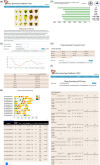Tartary buckwheat database (TBD): an integrative platform for gene analysis of and biological information on Tartary buckwheat
- PMID: 34783225
- PMCID: PMC8593524
- DOI: 10.1631/jzus.B2100319
Tartary buckwheat database (TBD): an integrative platform for gene analysis of and biological information on Tartary buckwheat
Abstract
Rice, wheat, corn, and potatoes are four crops that provide a daily source of nutrition for humans, but there are many problems that have been found with these crops. First, they lack amino acids and minerals which are necessary for balanced nutrition, and they also are grown very widely and as monocultures, which increases the risk of the human food system being destroyed by climate change. Thus, by introducing coarse cereals with good characteristics, we can enrich human food resources, realize agricultural diversification, improve dietary structure, and mitigate risks. Tartary buckwheat (Fagopyrum tataricum) is a widely cultivated edible and medicinal crop with unique nutritional and excellent economic value. It contains flavonoids, such as rutin and quercetin, which are not found in cereal crops. Rutin is a major flavonoid that can enhance blood flow and aid in the use of vitamin C and the production of collagen. In addition, such antioxidants have been shown to effectively reduce cholesterol levels, blood clots, and hypertension, particularly for the prevention of inflammatory liver injury (Middleton et al., 2000; Lee et al., 2013; Suzuki et al., 2014; Huang et al., 2016; Nishimura et al., 2016). Meanwhile, Tartary buckwheat can tolerate poor climate and acidic soils containing high amounts of aluminum, which is toxic to other crops (Wang et al., 2015). The self-pollination of Tartary buckwheat has resulted in a decrease in genomic heterozygosity, which is valuable for breeding and a stable production trait (Wang and Campbell, 2007). Therefore, Tartary buckwheat is an important minor crop, which is expected to become the target of many breeding efforts in the future.
Figures


References
MeSH terms
Grants and funding
LinkOut - more resources
Full Text Sources

